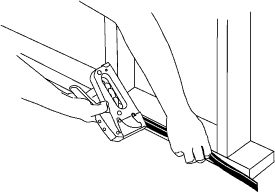 General Information
General InformationGreen Roofs
Rainwater Harvesting
Ponds and Wetlands
Energy-Efficient Building
Design Principles
Weatherseals
Building Gaskets
Glazing Gaskets
Timber Glazing
Air-Vapor Films
Attic Access
Ventilation
Sealants
Shim Screws
Wood Repair
Documents
Waterproofing

BUILDING GASKETS
A well-insulated building may not be energy-efficient, comfortable, or safe unless adequate attention is given to air sealing. Air leakage between sill plates and foundations, between wall plates and floors, between drywall and studs, between window or door frames and rough openings, and through other cracks and openings can lead to high utility bills, uncomfortable drafts, and unpredictable indoor air quality.
Effective air sealing requires more than simply caulking or spraying foam. Building materials expand and contract with temperature and humidity fluctuations, walls settle with age, and roofs flex in the wind or when loaded with snow. Long-term performance requires durable, elastic materials that will respond to this movement over the life of a building.
Our gaskets meet the most stringent installation and performance criteria. Developed for the Swedish manufactured housing industry, they have been in use for a half century in one of the world’s most rigorous climates. They’re made from cellular (foam) EPDM, a synthetic rubber with extraordinary aging properties. Compare them with other common sealing products:
• Plastic foam gaskets are too stiff for drywall sealing. Our gaskets are soft and easy to compress. • Plastic foam gaskets lose their ability to respond to movement after long term compression. Our gaskets suffer very little “compression set”, so they respond well to settling, shrinkage, and warping for decades after installation. • Caulks and adhesives can’t be used with building materials that are wet, dirty, or cold. Our gaskets are stapled or wedged in place, so surface conditions are of no consequence. • Spray foams expand when applied, often bowing window and door jambs, and may contain gases that are harmful to the environment and chemical compounds that are harmful to the installer. Our gaskets pose no threat to the building, the builder, or the environment. • Saturated polyurethanes stiffen in cold weather and become very difficult to apply. Our gaskets remain flexible to -60°F and can be applied in sub-zero conditions while wearing gloves. • Caulks and spray foams have short shelf-lives and must be used soon after opening. EPDM gaskets have an indefinite shelf life, so leftovers from one job will be usable years later. |
STRUCTURAL GASKETS: Structural gaskets are designed to seal under heavy loads, such as under sill plates, wall plates, roof panels, wall panels, and rim joists. Since they are effective moisture barriers, they eliminate the need for dampproofing between wood and masonry or concrete foundations. We stock three sizes: BG65 for 2 x 6’s, BG63 for 2 x 4’s, and BG61 for edges of rim joists, joints in exterior foam sheathing, or connections between stress-skin panels and posts or purlins.
![]()
BG61 for rim joists
![]()
BG63 for 2x4 plates
![]()
BG65 for 2x6 plates

Staple the structural gasket to the underside
of a sill plate with the flat side of the gasket
against the wood; then fiip the wood over.
GAP GASKETS: Gap gaskets seal gaps, such as those between window or door jambs and the rough framing. They seal air as effectively as spray foams, yet are much more durable and elastic. When polyethylene is used as an interior vapor barrier, the plastic should be tucked into the shim space around windows or doors before a gap gasket is pressed in place. That way, the gasket seals the gap and anchors the plastic at the same time. We offer three sizes of gap gaskets: BG44 for gaps 1/4” to 1/2”, BG46 for gaps 3/8” to 3/4”, and BG48 for gaps 1/2” to 1”. Remember to frame window openings at least 3/4” wider and taller than the window frame to assure sufficient space for a proper air seal. We also recommend mounting windows and doors with our shim screws to permit an uninterrupted air seal.
BG44 |
BG46 |
BG48 |

Using a putty knife or scraper, press the gap gasket into
the gap between the window frame and the rough opening.
DRYWALL GASKETS: BG32 drywall gaskets are stapled to wall studs, top plates, and bottom plates before drywall is installed in order to prevent air flow between the drywall and the wood. They can be easily installed in any weather, even when wood is cold, wet, or dirty. The head of the seal compresses easily to less than 1/8”, so there is minimal pressure on the drywall. Always screw the drywall where gaskets are used.
BG32 |
|
 Staple BG32 to the edge of bottom plates, top plates, and corner studs. |
|
P-GASKETS: P-gaskets solve many difficult sealing problems such as joints between logs, structural insulated panels, and sections of manufactured homes. All feature wide stapling flanges for easy installation in any weather, even when the lumber is wet or dirty. The hollow center assures effortless compression over a wide range of movement. We stock three sizes: BG34 for gaps up to 3/8”, BG36 for gaps up to 5/8”, and BG38 for gaps up to 7/8”.
BG34 |
BG36 |
BG38 |
PRICING: Call or email for current pricing.




